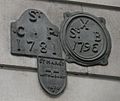St Christopher le Stocks facts for kids
Quick facts for kids St Christopher le Stocks |
|
|---|---|
 |
|
| Location | Threadneedle Street, London |
| Country | United Kingdom |
| Denomination | Anglican |
| Architecture | |
| Architect(s) | Christopher Wren |
| Closed | 1781 |
| Demolished | 1782 |
St Christopher le Stocks was an old church in the heart of London, England. It stood on Threadneedle Street, near where the Bank of England is today. This church was very old, built in the Middle Ages. After a huge fire in London in 1666, it was rebuilt. But in 1781, it was taken down to make space for the Bank of England.
Contents
History of the Church
People first wrote about St Christopher le Stocks in 1282. The church's name might come from the "City Stocks." These were a public punishment device once near the church. Others think the name refers to the nearby Stock Exchange.
Rebuilding After the Great Fire
In 1666, the Great Fire of London badly damaged the church. Luckily, its outer walls and tower were still standing. A famous architect named Christopher Wren rebuilt the church in 1671. He used many of the old parts that survived the fire. This was one of the first churches Wren finished after the fire.
An old book from 1708 described the rebuilt church. It said the old parts looked "Gothic." The new inside pillars were "Tuscan" style. The walls were made of old stone, covered over.
What the Church Looked Like
In the early 1700s, the church was about 22 meters (72 feet) long. It was 16 meters (52 feet) wide and 12 meters (40 feet) high. The tower was about 24 meters (80 feet) tall. It had only one bell, as the others were lost in the Great Fire.
Inside, the church had a wooden ceiling. It was divided into square panels. Each arch had a carved angel on its center stone. The lower walls were covered with oak wood panels.
Why the Church Was Demolished
During the 1700s, the Bank of England grew bigger. It bought more and more land around the church. In 1781, the Bank made a deal to take down the church. They wanted more space for their buildings.
They also worried that people might use the church to attack the bank. This fear came after the Gordon Riots in 1780. So, the church was pulled down in 1782. The land where the church stood is now part of the Bank of England.
Some parts of the old church still exist. For example, some carved wooden panels from the pulpit are now in St Nicholas's Church in Canewdon, Essex. These carvings are very detailed.
Burials and Remains
Many people were buried at St Christopher le Stocks church. In 1867, their remains were moved to Nunhead Cemetery in South East London. More remains were moved there in 1933 when the Bank of England was rebuilt again.
One famous person buried at the church was Thomas Harriot. He was a scientist who mapped the Moon's surface using a telescope. He was one of the first to do this.
Images for kids



